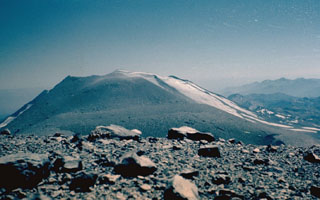Report on Nevados de Chillan (Chile) — 2 June-8 June 2021
Smithsonian Institution / US Geological Survey
Weekly Volcanic Activity Report, 2 June-8 June 2021
Managing Editor: Sally Sennert.
Please cite this report as:
Global Volcanism Program, 2021. Report on Nevados de Chillan (Chile) (Sennert, S, ed.). Weekly Volcanic Activity Report, 2 June-8 June 2021. Smithsonian Institution and US Geological Survey.
Nevados de Chillan
Chile
36.868°S, 71.378°W; summit elev. 3180 m
All times are local (unless otherwise noted)
SERNAGEOMIN reported continuing explosive and effusive activity at Nevados de Chillán’s Nicanor Crater during 16 May-2 June, and increased sulfur dioxide emissions and thermal anomalies. Explosions partly destroyed the dome, generating ash plumes that rose as high as 1.4 km above the crater rim and pyroclastic flows that traveled as far as 1.1 km down the NE flank. Satellite images indicated that the L5 lava flow did not lengthen, remaining at 966 m, though the distal part of the flow widened. The L6 lava flow advanced at a rate of 1.16 m per hour to over 890 m long. The average temperature was 101 degrees Celsius with a maximum of 264 for L5 and an average of 121 degrees Celsius with a maximum of 293 for L6. A new lobate flow emerged just to the N of L6; measurements on 2 June indicated that the temperature of the flow was similar to that of L6. Data indicated that the lava dome in Nicanor Crater did not get larger. The average sulfur dioxide emission rate was 706 (± 216) tons/day, reaching a high value of 1,101 on 27 May. The number and intensity of thermal anomalies increased, and were notable on 20, 23, 25, 28, and 30 May, likely due to the active lava flows. The Alert Level remained at Yellow, the second lowest level on a four-color scale. ONEMI stated that Alert Level Yellow (the middle level on a three-color scale) remained in place for the communities of Pinto and Coihueco, noting that the public should stay at least 2 km away from the crater.
Geological Summary. The compound volcano of Nevados de Chillán is one of the most active of the Central Andes. Three late-Pleistocene to Holocene stratovolcanoes were constructed along a NNW-SSE line within three nested Pleistocene calderas, which produced ignimbrite sheets extending more than 100 km into the Central Depression of Chile. The dominantly andesitic Cerro Blanco (Volcán Nevado) stratovolcano is located at the NW end of the massif. Volcán Viejo (Volcán Chillán), which was the main active vent during the 17th-19th centuries, occupies the SE end. The Volcán Nuevo lava-dome complex formed during 1906-1945 on the NW flank of Viejo. The Volcán Arrau dome complex was then constructed on the SE side of Volcán Nuevo between 1973 and 1986, and eventually exceeded its height. Smaller domes or cones are present in the 5-km valley between the two major edifices.
Source: Servicio Nacional de Geología y Minería (SERNAGEOMIN)

